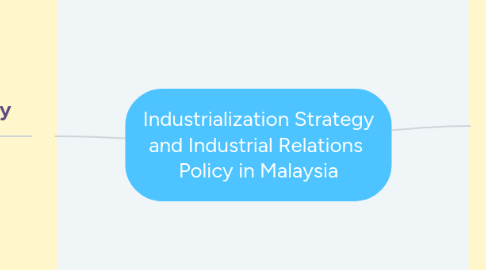Industrialization Strategy and Industrial Relations Policy in Malaysia
por Nur nurfhaizzati


1. Repressive
1.1. Unions were not permitted to bargain on issues relating to management decisions
1.1.1. transfer
1.1.2. promotion
1.1.3. recruitment
1.1.4. termination of employment
1.2. all collective bargaining agreements had to be "cognized" (certified) by the Industrial Court.
1.2.1. The court had the power to refuse to cognize if the agreement contained provisions that were deemed not to be in the national interest.
1.3. the dependence on low-cost, labor-intensive manufacturing for export forced the government to enact policies
1.4. state increased its involvement in the industrial relations sphere to a considerable extent, moving from controlled pluralism to repression
1.5. government has repeatedly refused to enact comprehensive minimum wage legislation, despite repeated demands by trade unions.
1.6. calculation of overtime was changed to reduce costs.
1.7. refusal of the government to enact equal pay for equal work
1.8. the general banning of trade unions in the export sector
1.9. employee fear their employer reprisals if they join a union
1.10. Employers clearly use both union suppression and union substitution strategies in dealing with workers
1.11. The owner of one U.S. electronics factory offered a box of Kentucky Fried Chicken to any worker willing to disclose the name of persons signing a union membership application.
1.12. Another U.S. corporation invited a Muslim religious instructor to speak during working hours about why it was against the Islamic faith for women to become members of a union.
1.13. Workers in these companies who have exhibited pro-union sentiments have routinely been transferred to other plants and intimidated.
1.14. Hitachi's Malaysian subsidiary fired 1,003 striking workers after they walked out in protest of the government's refusal to allow their in-house union to be represented by a national electrical workers union.
1.15. on Act of 1955, strikes were allowed but after Industrial Relations Act of 1967, strikes were prohibited once the dispute had been referred to arbitration by the minister of labor.
1.16. Foreign companies manufacturing for export were exempted from the ICA policies on Malay share ownership, and labor laws that might have discouraged foreign investment were relaxed or went unenforced. Unions were excluded from key industries and the export sector.
1.17. Through the Heavy Industries Corporation (HIC), the state now had a leading role in establishing large-scale, capital-intensive, import-substituting industries to provide industrial goods and consumer durables for the domestic market and a foundation to support a range of private sector and consumer goods industries.
1.18. development priorities once again shifted to EOI from a policy of heavy industrialization for an increasingly protected domestic market
1.19. the shortage of revenues brought about by the government's involvement in NEP, ICA, and the HIP, and the consequent increases in international debt, that brought about the shift to EOI policies
2. Exclusionary
2.1. minister of labor extended the tax and labor-exempt policies for Pioneer industries and industries in export processing zones (EPZs).
2.2. electronics industry has been exempted from the provisions of the Employment Act (1955),
2.3. grant exemptions from labor laws to foreign companies
2.4. investment incentives have been restructured to attract higher technology-based investments, and the Malaysian education system has been deregulated, resulting in a mushrooming of private colleges with exchange arrangements with universities in Australia and Canada.
2.5. the government enacted the Human Resources Development Act of 1992, which instituted the Skills Development Fund.
2.5.1. The law forces larger enterprises to pay a certain percentage of their payroll costs into the fund, to which the government contributes a matching sum.
2.6. Immigration policies have also been restructured to permit the import of both skilled and unskilled guest workers to meet the demands of industry.
2.7. Policies oriented toward skills development at the national level are complemented by employer approaches emphasizing increased worker involvement.
2.7.1. The movement in the electronics industry is toward increasingly positive human resource management in a nonunion environment.

